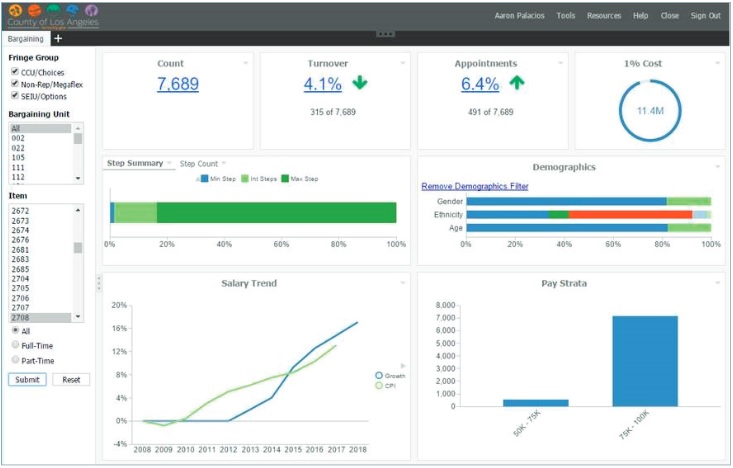Context – custom needs
The County of Los Angeles is one of the largest in the US by population, geography, and size of administration. Approximately 100,000 employees work for county government, which serves more than 10 million residents. Comprised of 38 departments, governed by five Board Supervisors, the county delivers health, social, fire, accounting, law enforcement, and a range of other public services.
is one of the largest in the US by population, geography, and size of administration. Approximately 100,000 employees work for county government, which serves more than 10 million residents. Comprised of 38 departments, governed by five Board Supervisors, the county delivers health, social, fire, accounting, law enforcement, and a range of other public services.
Los Angeles County operates with a budget of over $30 billion, of which salaries and employee benefits consume approximately $10 billion, or about one-third of the total. Oversight for all departments in terms of budget and other administrative requirements is provided by the Chief Executive Office (CEO). In this work, the CEO has need to quickly access and analyze large amounts of data, which generally resides in HR and payroll systems. For example, the CEO’s Employee Relations Classification Benefits and Compensation Division is responsible for labour negotiations on behalf of various departments, meaning it needs to manage relationships with over 60 different bargaining units. Every three years, it must negotiate with labour unions on compensation and other issues for a highly diverse workforce. The county has 2,200 different job classifications, ranging from custodian to neurologist, and including sheriffs, accountants, postal workers and firefighters. According to Napoleon Valera, manager of the Benefits and Compensation Division in the Chief Executive Office, “we needed a better way to assess the impact of labour negotiations. If a labour union presented a proposal for a salary enhancement, we would need to be able to cost this, and to have this information right away.”
To support information needs, the county originally relied on personnel and pay data that was extracted from a traditional FOCUS-enabled mainframe database. The CEO employed a couple of programmers who would use the FOCUS 4GL language to create scripts that would build database queries. However, when the county transitioned to a massive, CGI-based ERP solution with a larger database, all systems, including payroll and personnel systems, changed, and existing methods of coding were no longer efficient.
The standard analytical tool for CGI ERP, and the tool the county used, was the IBM Cognos product. As Valera explained, Cognos was suitable for creating standard production reports, and appropriate for 95 percent of the county’s work. However, the CEO had unique needs that could not be met with the standard tool: “the type of work we do in the Chief Executive Office is very surgical [need advanced capability to slice and dice the data], very analytical, and it involves large amounts of data. No other departments do what we do: the Cognos platform was not really designed to accommodate our needs, so we had to go out and seek a better way.”
The timing of information retrieval was another challenge. To generate insights from the mainframe database environment, the CEO would dump data over a day and a half and drop it into Excel – and try to program it by first creating cubes that could accommodate multiple data sets. This approach works, Valera noted, if requirements are predefined: “If you know what you want, you build a cube, and that will address your needs. But the problem we have, in dealing with 60 different bargaining units, is that you never know what new information needs are coming. So there’s no time for us to send in a request to our main IT folks to create a cube.”
Why Information Builders?
A FOCUS user for over 20 years, Los Angeles county’s CEO turned to Information Builders’ (IB’s) business intelligence tool WebFOCUS five years ago to address the CEO’s need for greater agility and flexibility in data management. A key advantage of the IB platform over that of other vendors was the IB tool’s ability to adapt to the legacy data in the FOCUS database, which contained many historical records. Valera’s team was also drawn to WebFOCUS for its ability to tie in multiple data sources. Across 38 departments, the county had information in Oracle systems, Oracle databases, CGI databases, and even some Excel stores.
Cost benefit was another consideration: according to Valera, modification of the IBM CGI environment to accommodate CEO needs would cost more than the initial WebFOCUS investment. And this financial advantage extended to actual work with the product. With CGI, he explained, it was not possible to work independently – rather, a consultant had to be on hand to monitor changes or adaptations. In contrast, Information Builders taught the CEO team what was needed to use the tool on their own. “IB taught us how to do it. We were able to extrapolate from this, and whenever we needed help, we would bring it back in [to IB]. This has been a successful model for us. You couldn’t have that flexibility with the other vendor.”
IB ability to teach the platform was in many ways a function of the tool’s user-friendly interface. In comparison to Cognos complexity, the IB tool promised a simpler user experience. Another key consideration was the visual capability in IB’s analytics tool, which would increase the impact in report presentations that, unlike production reporting, are “different every time.”
Implementation – easy for analysts
Prior to portal development, the CEO team needed to secure sign off from the IT department to shift to a new analytics supplier. To convince IT that they needed something beyond Cognos – a toolset that would better address CEO needs – Valera’s group did a proof of concept to test how the old system could handle requests: how it would perform when reporting off multiple, large data sources and how it would adapt to data sources to extract information. Based on results from the PoC, Valera explained, the team managed to demonstrate that something different was necessary.
Valera described set up to ensure quick and easy query of the data as “quite an undertaking.” The CEO team, including internal systems specialists, worked with an IB consultant to create a reporting environment that was very user friendly. “I didn’t want any longer to have to rely on one or two people on the team to review the FOCUS language programming in order to do the job. My thought was that system should be user friendly enough so that if a user can book a flight on Expedia, he/she would be able to do costing.” Since the majority of the portal users would be business analysts – domain experts in benefits and compensation, but not necessarily technical people – a key focus in design of the system was to make the analytics simple to use. Ultimately, the self-service portal was based on a user-defined “cafeteria” plan with a series of drop-down queries that would take the user through the department, bargaining unit, and data type needed for reporting.

parameterized display forms for querying the data in a simple, and straightforward way.
According to Valera, one of the biggest challenges in implementation was convincing other county divisions that the new portal was for their group only – that the CEO would use it surgically, and the deployment would not impact other divisions. Today, WebFOCUS is beginning to scale in other departments, including Internal Services and the Auditor Controller division. Given the CEO’s purview over all 38 departments, Valera reckons that WebFOCUS now touches all areas in the county.
Outcomes – compliance
Data insights are valuable inasmuch as they can be applied to business challenges. An important initiative that the county is now working on is gender pay equity; its goal is to be cognizant of issues, and to address them in a proactive, rather than reactive way. According to Valera, the county is now constantly engaged in monitoring the situation, using data analysis enabled through WebFOCUS to make sure it is on a path to improving equity. If there is indication of inequity in a report, the county now looks to prevent this from continuing or developing into a much bigger problem.
To illustrate, Valera noted that the county was audited on gender equity in 2014 and asked to explain why, if pay scales advance automatically, there was a gender pay gap. Most of the county’s 100,000 employees are hired in a prescribed way and they advance through pay rate “steps” based on time/performance in the posting. Reporting which showed that males in a particular job classification were making 20 percent more than females served as a flag for state auditors. But using WebFOCUS, the county was able to drill down into the data, and attribute the gap to the fact that the majority of hires were originally male – historically, certain careers may not have been attractive to all genders. “The majority that came in originally were males who have come over time to achieve higher pay scales,” Valera reasoned, “but when you begin to hire women, they come in at stage one.” So the gap had to do with the impact of seniority and historical hiring, not current county policy; the OCE was able to use business intelligence and data to validate that the original findings of bias were misleading.
Beyond demonstrating compliance with gender requirements, the county also uses business intelligence to try and bridge potential issues. For example, when a new employee is provided extra compensation to attract them to a position that has been difficult to fill, the OCE team can use the IB tool to ensure that there is not a qualified female who is working at a lower pay grade. To make proactive improvements, the county also uses WebFOCUS to ensure gender neutral hiring – scanning applicants’ data to ensure they are not interviewing, and hence hiring, a preponderance of males in a particular job classification. On a daily basis, the county also uses the tool to assess the impact of a request from a particular department for a benefits increase for a specific position – how would this affect similar roles in other departments, and ultimately, the county budget as a whole?
Benefits – cost
In addition to the cost benefits of shifting to IB noted above – for example, the implementation cost comparison with the incumbent provider – the county was able to tap into additional sources of cost savings. With IB analytics, the CEO has been able to access data without the help of multiple programmers – and reduce the team from 30 to 8, freeing up staff to work on other tasks. By adopting an easy to use tool, Valera has helped those remaining analysts to work more independently, ultimately improving worker efficiency. And through ongoing monitoring for errors, the CEO is able to make improvements to the bottom line. For example, overpayments can be significant – in the millions of dollars – and difficult to claw back once a precedent has been established. However, by using WebFOCUS to establish rules-based thresholds, the county is able to raise the flag on an anomaly, and alert the department involved – often before benefits go to payroll.
With advanced analytics, the county also delivers social benefit: the development and use of fairer hiring practices helps citizens as well as potential and current employees, who will register individual impact. A final benefit involves accountability. If it can measure and report on the impact that it is achieving, the county provides greater transparency, an important, but often elusive aspiration for many administrations. “When you spend $50 million on a project,” Valera asked, “how can you explain what the benefit was?” For Los Angeles County, a big part of the answer has been WebFOCUS, which delivers the data needed to develop a policy framework, and to support adherence to a rules-based, ethical operation.








